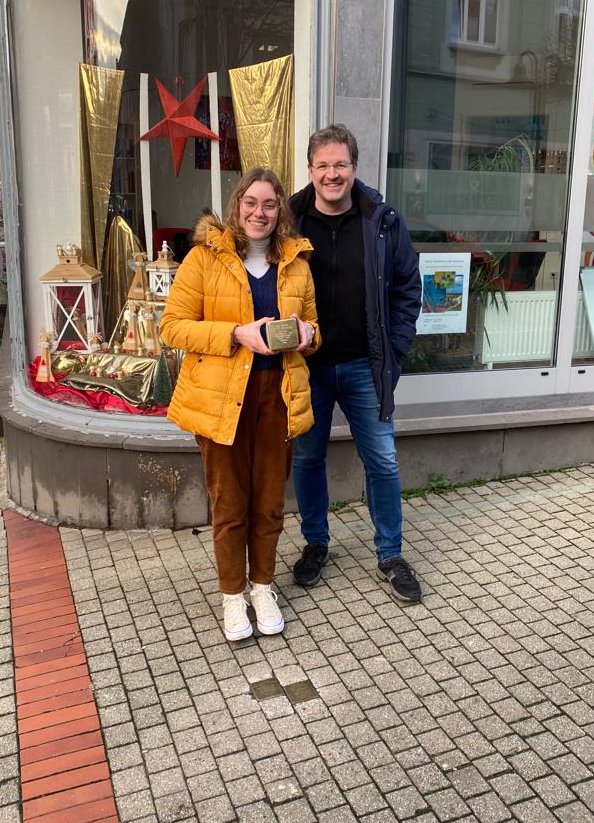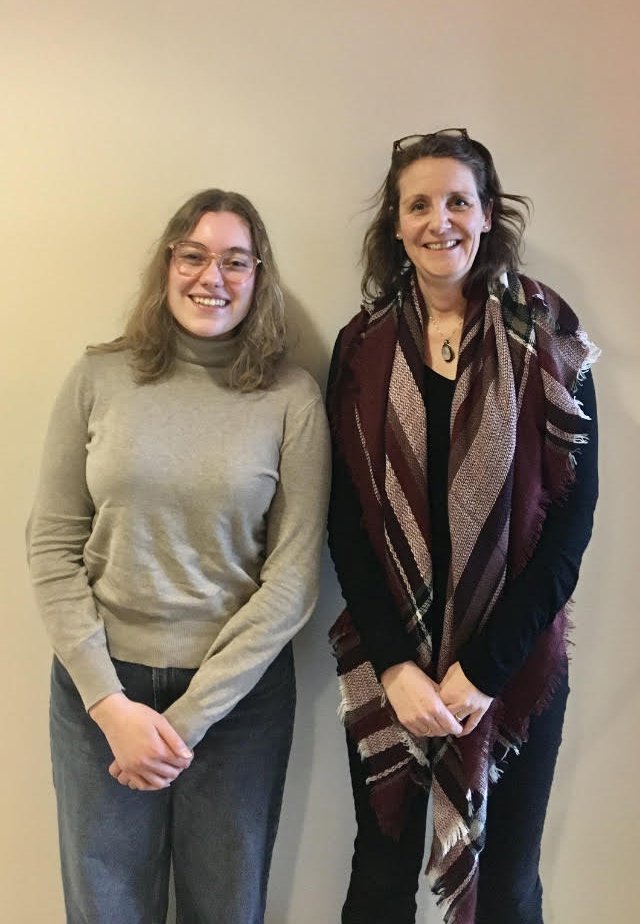A&S Student Honors Holocaust Survivor through Research Project
Courtney Conte ’23 helped prepare a “stumbling stone” to remember Bob Hyman’s life.

When Courtney Conte ’23 set foot in the town of Bochum, Germany, it only took a few steps, literally, for her to appreciate the importance of her visit. As she walked around the streets of the town, she kept seeing Stolpersteine, or stumbling stones, that delivered a powerful reminder of why she was there. Stumbling stones are small bronze plaques that you can find embedded in sidewalks around Bochum – and all over Europe to remember and honor victims of the Holocaust. The idea is that pedestrians will stumble upon the stones, much like Conte was doing, and stop to think about the people who endured the atrocities of the Holocaust.
Conte was in Bochum to honor the life of Bob Hyman by researching his personal story, with the hope of uncovering enough details to create a stumbling stone for Hyman. Hyman, formerly known as Otto Heimann, was a Holocaust survivor from Bochum-Langendreer who had been captured by the Nazis and interned at the former concentration camp in Sachsenhausen when he was a teenager. He was later granted asylum in England, then moved to Canada and later to the United States, where he passed away in Miami, Florida, in 1998.
Conte was pursuing this research project to honor Hyman’s life through the laying of a Stolperstein. Stumbling stones typically show details about each person's life, such as their birth date, place of birth and where they were interned, if they were granted asylum and when they passed away. She also prepared a presentation about Hyman for Bochum’s archives. Conte received a SOURCE grant to support her position as a research assistant for this project.
This intentional remembrance of the Holocaust and each individual victim is exactly what drew Conte to this project, which Conte completed for academic credit.
“My education never really covered anything beyond the basic information about the Holocaust – and having the opportunity to learn more about how it really affected someone and their family contextualized the Holocaust in a different and incredibly powerful way,” she said. “It's so important for people to have more than just the numbers or the broad historical facts about the Holocaust. These personal stories offer so much.”

Conte was introduced to stumbling stones through a German class that she was taking during her junior year with Professor Mona Eikel-Pohen, associate teaching professor of German in the Department of Languages, Literatures, and Linguistics in the College of Arts and Sciences (A&S). She was immediately drawn to the project because it offered such a powerful perspective on the Holocaust. When the opportunity came up for her to conduct her own research to support the installation of a new stumbling stone, she seized the chance.
Eikel-Pohen lived and studied in Bochum and has since connected with Andreas Froning, the Bochum town archivist, who works on finding information for stumbling stones and locating family members of Holocaust victims from Bochum. The partnership with Syracuse aided his efforts during the pandemic when one of Eikel-Pohen’s courses, which Conte took part in, helped Froning find the American family members of another Holocaust victim. It can be challenging for Froning to connect with relatives outside of Germany due to language barriers.
“This research project offers students transatlantic cultural, social and critical engagement with the Holocaust,” Eikel-Pohen said. “And it raises awareness for the need of a commemorative culture both in Germany and the United States.”
Conte reached out to Froning when she started working on this project and was able to get some preliminary information about Hyman from him. She also drew from archival materials like photographs, newspaper clippings, national records in England, and memorial records from the former concentration camp to piece together a narrative about Hyman’s life – and track down key details for the stumbling stone. Conte also researched obituaries to find his family and connected with his descendants, including Hyman’s nephew and sister-in-law, to hear their stories and memories of Hyman – and to share her findings. She found that after he was granted asylum in Canada, he moved from there to New York and started his own business making handbags.
“Seeing photos of Bob's business in New York was one of the most inspiring parts of the project,” she said. “To find out that he was displaced from his home and lost his family at such a young age, and then moved to England, Canada and the U.S. and launched his own business. It is just incredible that he was able to make handbags and work for himself in New York after going through so much.”
Conte met with Froning in Bochum, visited the town’s archives, and toured Bochum’s streets and stumbling stones. She was able to see the stone for Hyman, which will be installed in June, by Gunter Demnig, the creator of the Stolpersteine project. The official ceremony will be attended by the descendants of Hyman that Conte located through her research as well as high school students from two local schools.
“It was amazing to see the stone and hold it in my hand,” she said. “I really hope Bob’s story will move others as much as it moved me.”
Featured
Mona Eikel-Pohen Associate Teaching Professor, German; Modern Foreign Language Coordinator
